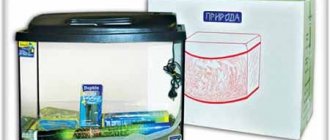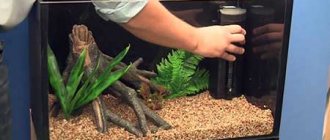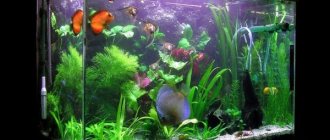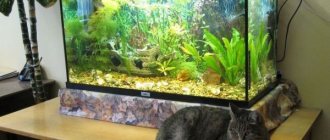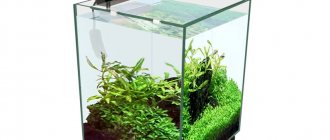Home › Aquarium equipment ›
( 1 ratings, average: 4.00 out of 5)
Aquariums of 30 - 40 liters are the most common home aquariums. What is the reason for such popularity?
Maybe you are a beginner and just decided to try yourself in a new hobby? Or are you not yet sure that you will not give up this idea? Then this is the right choice.
30 liters or 40 is a small volume of water. Not every novice aquarist will decide to purchase a large aquarium right away. A large capacity takes up a lot of space, and this is very important if you have a small apartment.
Equipment also takes up a lot of space - external filters, CO2 generator. In addition, a large aquarium means a larger volume of water that you will have to work with and make regular changes.
On the other hand, an aquarium with a volume of 30 to 40 liters is already a fairly large container. In such an aquarium you can plant more plants, add more fish and shrimp, have more space for decoration, and the environment in it will be more stable than in a 10-20 liter tank, which means there is a greater chance of a long-term existence of a mini aqua system.
An aquarium of 30-35-40 liters is a fairly small budget expenditure, but it is a full-fledged, albeit small, living world with a diverse population. This is a good choice for a beginner aquarist.
Types of aquariums
Aquariums from 30 liters most often have a length of 45 cm, a width of 25 cm and a height of 25 cm.
Shapes can be different: cubic, rectangular, with convex walls.
Material: glass, acrylic, highly transparent glass. It is better to give preference to glass - it is a more durable material, it does not scratch when cleaning algae from the walls. Also, glass remains transparent for a long time, while acrylic can turn yellow from sunlight. Acrylic, however, is a lighter material; in some cases it should be preferred.
Often such aquariums are sold together with equipment - lighting and filter.
The cost of equipment is usually low, which allows beginners to try a new hobby without spending too much money.
Beginners should understand that controlling balance and maintaining cleanliness and stability is much easier in larger aquariums. You have to take care of a 30-40 liter aquarium more often than larger ones.
Let's consider several options from best manufacturers.
Aquael SHRIMP SET SMART 30 liters
This aquarium is from the SET SMART line of Aquael aquariums, designed for breeding shrimp and small fish.
Size
29 x 29 x 35 cm.
Equipment
The kit includes an aquarium tank, a cover glass, a protective lining for the tank, an LED lamp, an inner filter, a heater, and shrimp food.
Description
A beautiful cubic aquarium. You can keep it not only shrimp, but also small fish, including betta. The composition includes almost everything you need, you just need to buy some soil.
Tetra AquaArt Aquarium Complete Set Discover Line 30 liters
Size
39 x 27.5 x 42.2 cm
Equipment
- Durable, distortion-free float glass container.
- Innovative Tetra EasyCrystal filter.
- Cover with 8 W T8 fluorescent lamp.
Description
This is an option from Tetra for keeping tropical aquarium fish. There are also other 30 liter options: Tetra AquaArt LED Aquarium 30L Goldfish for keeping goldfish with an LED lamp, Tetra AquaArt LED Explorer Line 30L White Edition - a white aquarium for keeping crayfish and crustaceans with a curved front wall.
Aquariums Nature
Dimensions
Capacities 32, 34, 40 liters.
Equipment
A rectangular glass container with a flat or oval front glass.
Cover with fluorescent lamps.
Description
High-quality inexpensive aquariums from a Kharkov manufacturer.
Equipment
As can be seen from the types of aquariums presented, many of them are sold in a set with the necessary equipment. However, the kit does not always have everything you need, and it is often more profitable to take only a water container and buy the missing equipment yourself. And, by the way, you can buy higher quality equipment separately. Let's consider what we generally need to equip the aquarium.
Filter
Perhaps the filter is the most important addition to the aquarium. An aquarium filter helps keep the water clean and healthy, which is especially important in small tanks such as 30-40 liters where nitrates accumulate faster and the water volume is smaller.
There are several different types of filters. If you are going to keep a small number of fish, then it is enough to purchase an internal filter. If you plan to use all the biological space, that is, populate the aquarium with fish and other animals to the maximum, then choose a filter with good biological filtration - canopy or external.
However, the choice of filter also depends on everything that will be in the aquarium: living plants, types of fish, type of soil.
If a large number of plants and small tropical fish or shrimp are expected, then it is enough to choose any internal or other filter; biological filtration is not so important.
If you want to keep goldfish or other types of “dirty” fish, you need to choose a more powerful filter that passes at least 5 volumes of aquarium water per hour.
If there are no plants, then you should give preference to filters with predominantly biological filtration.
Various manufacturers offer filters of different power, you need to choose according to the size of the aquarium and the population. The filter should pass 3-5 volumes of aquarium water per hour.
The cost of filters varies, on average from 20-30 dollars and more. But if you want to choose more expensive equipment, then know that investing in a filter is always justified.
Lighting
What kind of lighting is needed in an aquarium also largely depends on its contents. Therefore, you need to decide before purchasing which plants, fish and other animals will live there.
Some plants require strong light, otherwise they will stop growing, wither, get sick and eventually die. Even if the lamp is included, you may have to buy additional lamps, or replace the standard ones with brighter ones. You can find out more about the requirements for maintaining aquarium plants in the catalog.
Some fish also require brighter lighting, while others prefer darker conditions, and this must be taken into account both when choosing lighting and when choosing plants.
If you are a beginner and are buying a complete aquarium, then first choose aquarium plants for beginners - they grow in medium and even low light.
Heater
Heaters are very rarely included in an aquarium starter kit, as they are needed primarily for keeping tropical aquarium fish and shrimp, as well as for marine installations. If your chosen tropical fish require heating, you will have to buy a heater yourself.
There are not as many heaters on sale as filters, and they work the same way - just install the equipment in the aquarium and set the desired temperature. Choose a heater only with a thermostat. The heaters always indicate the displacement of the appropriate volume of water.
The heater is always installed closer to the water flow from the filter.
A thermometer is not included in the kit, but you must purchase one yourself in order to control the water temperature. A thermometer is placed on the opposite side of the heater to ensure that the entire tank is maintained at the desired temperature.
Priming
The next important point that beginners pay little attention to is aquarium soil. However, it is an important aquarium equipment for several reasons.
Calculate the amount of soil for the aquarium
The choice of soil is determined by what and who will live in the aquarium.
If there are living plants, you need to choose the soil that is suitable for the plants first of all. There is now a good selection of soils on sale for growing healthy, beautiful aquarium plants.
For some tropical fish species, it is recommended to choose a substrate of darker colors - it not only imitates their natural habitat, but also helps to emphasize the beauty and brilliance of underwater inhabitants.
Aquarium plants are incompatible with goldfish - these pets love to dig up gravel and move decorations from place to place. But there should still be gravel at the bottom; it helps create a natural atmosphere. It is better to choose fine soil or sand.
Large cichlids are not suitable for keeping in aquariums up to 40 liters, but some small African cichlids are quite suitable. But for some of them there are special requirements for water parameters, namely alkaline PH. This can be achieved using special gravel for cichlids.
In any case, there must be soil in an aquarium with any aquarium fish (unless it is a spawning tank or a container for raising fry). Thanks to the substrate, the aquarium looks more natural, which reduces stress levels in fish and shrimp. The soil itself is a good aquarium filter.
Optional equipment
- Substrate. An aquarium with water, soil and other equipment is quite heavy, so it is better to take care of the surface on which it will be installed in advance.
- Compressor. Some fish require increased oxygen levels in the water, such as goldfish and some species of corydoras. Using a compressor, you can provide more oxygen to the water.
- CO2 generator . This equipment is only necessary if there are living plants, and even then not all species need it.
- Scenery. And again, everything depends on the future inhabitants of the aquarium. Most Amazon tropical fish will thrive among driftwood and living plants, as will most catfish, which prefer natural cover. Some species of cichlids, such as the aggressive mbuna, prefer the likes of rocky slopes, that is, caves made of stones. Both living plants and decorations are contraindicated for digging fish. And shrimp definitely need living plants, preferably mosses and any other shelters. If the future inhabitants of your aquarium do not have any special preferences, you can decorate it as you wish.
- A clean bucket, siphon, and net are necessary equipment for caring for an aquarium.
- Air conditioning, water tests for ammonia, nitrites, nitrates.
First steps
To start making your dream a reality, the first thing we do is buy not only a 40-liter aquarium, but also auxiliary devices, without which it will be very difficult to ensure a comfortable existence for its future residents. So, such equipment includes:
- Filter.
- Compressor.
- Thermometer.
Let's consider each of them separately
Filter
This device is rightfully considered one of the most important in terms of maintaining the ideal and stable state of the entire ecosystem in the aquarium. In addition, thanks to the continuous filtration of water, you don’t have to worry about the appearance of various dangerous microorganisms, dust or leftover food in it. But, despite the apparent simplicity of the operation of the aquarium filter, there are certain safety rules that simply must be strictly followed. So, they include:
- Avoiding leaving the device turned off for long periods of time. If this happens, then before turning it on, you must thoroughly wipe the entire device.
- Connect the device only if all its parts are completely immersed in water. If this rule is not followed, there is a high probability of serious malfunctions that will radically disrupt the functioning of the filter.
- Thoroughly wash the purchased device before immersing it in the aquarium for the first time.
- Maintain a minimum distance from the bottom to the attached device of at least 30-40 mm.
Remember that even the slightest negligence can seriously affect the entire microclimate in the aquarium. And this is not to mention the serious danger to which the fish living in it are exposed.
Compressor
In some cases, this device can be called the “heart” of any vessel. This device performs one of the most important functions for maintaining the life of not only fish, but also vegetation. A compressor is necessary to saturate the water with oxygen. It is installed, as a rule, in the outer part of the aquarium, both on the side and on its back. After this, you need to connect a special hose to it, which is subsequently lowered to the bottom and connected to the sprayer. Compressors can be of several types. Depending on the installation location: internal and external. If we talk about power, then: using batteries or operating from the mains.
One of the most common mistakes made by inexperienced aquarists is turning off the compressor at night. It is this act, which outwardly seems quite logical, that can lead to irreparable consequences, since it is at night that oxygen consumption increases significantly. Also, due to the suspension of photosynthesis processes, many plants begin to use carbon dioxide.
This device is also necessary for high-quality operation of the filter. It is worth emphasizing that even the presence of a large amount of vegetation in the aquarium does not lead to complete oxygen saturation of all inhabitants of the underwater world. And this is especially evident when the inhabitants of the vessel are not only fish, but also shrimp or even crayfish. Also, many experienced aquarists advise testing its operation on a container with vegetation before starting to install the compressor.
Important! It is necessary to constantly ensure that such a phenomenon as oxygen oversaturation does not occur.
Heater and thermometer
Another important attribute in maintaining the normal functioning of any aquarium is the constant maintenance of the required temperature. It is very difficult to overestimate the importance of a stable temperature in a vessel, since any sudden change in it can introduce a serious imbalance into the measured life of its inhabitants. As a rule, ideal values are considered to be between 22-26 degrees. If tropical fish are planned as residents of the aquarium, then it is more advisable to slightly increase the temperature to 28-29 degrees. But it is worth emphasizing that for better control of any temperature changes, it is recommended to purchase a thermometer in conjunction with the heater.
Lighting
The quality and level of light is quite important for maintaining comfortable life support in the aquarium. Therefore, it is not surprising that for the correct flow of all life processes in an artificial reservoir, you need to worry about the presence of artificial and high-quality light. Thus, the shortening of the day depending on the time of year speaks in its favor.
And if in the summer there may still be enough natural light, then after a couple of months the need for auxiliary lighting devices will completely disappear. In addition, it should be noted that the intensity and brightness of light directly affects both the growth of fish and their well-being. And this is not to mention the fact that the visibility of what is happening in the aquarium will be practically equal to 0.
Live aquarium plants
An aquarium of 30 liters or 40 liters is already quite a spacious container, so the choice of plants expands significantly. You just need to avoid large species.
Excluded
- aponogetones;
- large species of Echinodorus;
- large cryptocorynes;
- too large, fast-growing, long-stemmed aquarium plants.
Can be planted
- All types of aquatic mosses.
- All ferns except large ones (bolbitis gedeloti).
- Rosette plants: small and medium-sized Cryptocorynes, Echinodorus, Nymphoides, Vallisneria, Blyxa, Pogostemon helfera, Eriokauron sinerium and other small plants.
- All types of ground cover: Marsilia, Micrantemum Monte Carlo, Lilaeopsis, Hydrocotyla tripartira, Staurogyne, Hemianthus cube and many others.
- Long-stemmed. Many aquarium plants are suitable for keeping, especially in a 40-liter aquarium, but avoid large and fast-growing species - they can take up all the available space in a short time (especially in good lighting). And floating on the surface they will shade the entire space below.
- Anubias.
- Bucephalandra.
Aquarium fish, shrimp, snails
Thirty to forty liters is already a sufficient volume to accommodate a small flock of tropical aquarium fish up to 5 cm in length. But you should not overpopulate the container - in such a small space, the appearance of a large amount of nitrates, or even more so nitrites or ammonia, can lead to illness and even death of the population.
Excluded
- All large fish species (more than 10 cm) should be excluded. Or a 40-liter aquarium can be used “for growth,” so to speak, if you plan to purchase a larger container in the future.
You can start
| Name | Quantity |
| Guppy | 5-7 fish |
| Barbus cherry | 4-6 |
| Barbus Sumatran | 3-4 |
| Schubert Barbus | 4-6 |
| Cardinal | 7-9 |
| Rasbora cuneiformis | 4-5 |
| Rasbora espei | 7-9 |
| Pearl gourami | 2 |
| Gourami kissing | 2 |
| Danio rerio | 4-5 |
| Blue neon | 5-7 |
| Tetra Amanda | 10-13 |
| Corydoras panda, pygmy, habrobus, speckled | 3-5 |
| sword bearer | 2 |
| Minors | 5-7 |
| Microrasbora galaxy, erythromicron | 10-15 |
| Carnegiella | 6-9 |
| Tetradons dwarf | 5 |
| Pecilia | 4-8 |
| Apistogramma dwarf | 5-7 |
And other small fish. You can have from 4 to 10 of them, depending on the size of the adult. To find out for sure it is better to use a calculator to calculate.
- Cockerels. Even in a large volume, one individual can be housed, but the cockerel can be kept with other active and not very bright fish that are not similar to male cockerels.
- Ancistrus, Acanthophthalmus couleus - it is better not to purchase more than one individual and reduce the number of fish of other species.
- Goldfish. In a 40 liter aquarium you can only keep one adult goldfish, and even then it’s a stretch - these are quite large fish that need a lot of oxygen, so one individual requires 50 liters of water or 75 for a couple. For a group, a forty-liter aquarium can be used, but only for a while.
- Angelfish. Often, sellers assure buyers that a 40-liter aquarium is enough to keep them. However, the fish grow up and... die. This is because just one adult angelfish needs at least 40 liters of water. So again - only “for growth”.
- Large catfish - see above about angelfish and goldfish.
- African cichlids. Some species may be suitable even for keeping in such a relatively small volume of water (melanochromis maingano, auratus, yellow), but no more than two individuals.
- Neocaridine shrimp. In an aquarium of thirty or forty liters, shrimp can be kept either alone or with fish, you just need to provide these creatures with plenty of cover, and they will thrive. Aggressive species and biters are definitely excluded - cockerels, minors, barbs, mbuna cichlids.
What fish are suitable?
Not all fish can be kept in a 40-liter aquarium.
Of course, you can put almost any aquarium fish there, but as they grow up, some of them, sooner or later, will either begin to experience stress and die, or will try to push out their less efficient neighbors, which is why they will most likely die too. It is also necessary to take into account that among aquarium fish there are predators and fish with a heightened territorial instinct, showing aggression towards anyone who invades their territory. In a reservoir with a volume of 40 liters, these contradictions can cause serious disappointment. When selecting inhabitants for your aquarium, you need to inquire not only about their appearance, but also about their behavior and compatibility with other fish.
Peaceful guppies and neons are definitely suitable for such an aquarium. A flock of up to 16 individuals may be optimal. Larger swordtails and mollies will feel comfortable with only three pieces. A school of active Sumatran barbs or zebrafish numbering more than 8 can feel crowded. A flock of gourami of 3 fish will already be sufficient. For such a volume, two ancistrus catfish and no more than 4 speckled catfish will be enough.
It will be impossible to provide comfortable conditions for goldfish, most cichlids, and large catfish in 40 liters, and fish placed there at a young age will die as they grow up.
Aquarium installation
- A new aquarium can be washed with tap water to remove dust and dirt.
- Place the container on a sturdy, level surface, first placing a protective pad over it.
- The soil must be pre-rinsed (unless otherwise indicated in the instructions for use). Pour it into a clean bucket, fill it with tap water and stir. The procedure is repeated several times until the water is sufficiently clear.
- The soil is poured into the aquarium and placed along its bottom as desired. Decorations, driftwood, stones, etc. are placed.
- Fill with water that has been pre-treated with conditioner to remove chlorine. You will need about 3-4 buckets of water.
- Install a filter, heater, thermometer.
- Live plants can be planted when the aquarium is filled with water.
How to set up an aquarium correctly
It would seem that there is nothing complicated here. We buy an aquarium and place it in a previously prepared place, but do not be surprised if various unpleasant situations suddenly begin to arise. And all because simple safety rules were not followed during its installation. This is how they are classified:
- Installation only on a flat surface.
- Availability of sockets nearby. Although a 40-liter aquarium cannot boast of serious dimensions, you should not neglect placing it in an inconvenient place, thereby complicating access to it.
- Using various nutrient substrates as soil. And keep the soil thickness in the range of 20-70 mm.
Starting an aquarium
Immediately after installation, the aquarium is not ready to receive the population. The fact is that bacteria must first settle in it, processing fish waste products: breaking down ammonia into nitrites, and them into less dangerous nitrates. This process is called the nitrogen cycle, and starting an aquarium means allowing the nitrogen cycle to establish itself. The nitrogen cycle can take from 2 to 8 weeks to establish.
There are different options for starting an aquarium. There is an opinion that the container only needs to be left alone for this period, and the cycle will start. However, for the necessary bacteria to appear, they first need food - ammonia, and if there are no fish, then there is no food. Therefore, bacteria may not appear for a long time, especially in the required quantity. What to do?
Option 1: Add ammonia yourself at 2-4 ppm every few days. Then the water is tested using tests for the presence of harmful substances (ammonia, nitrites, nitrates). In a neglected aquarium, only nitrates can be in the water; there should be no other decomposition products, as well as ammonia itself. This is not the best option because it is difficult to determine the right amount of ammonia.
Option 2. Add preparations containing bacteria to start the aquarium. In this case, the bacteria again need food, and ammonia must be added. And there is an opinion that such drugs are a product of commercial PR and are little effective, if at all useful.
Option 3. Gradual biological filling. I believe that this is the safest and most effective way to start an aquarium. In this case, it is recommended to introduce fish (or shrimp) gradually, not all at once. In the first week, 1/3 of the maximum population - so the ammonia that appears in the water will be the least toxic to fish. After a week, the water is tested. If ammonia is not detected, the aquarium population is replenished.
Thus, the nitrogen cycle is established quickly enough and is least dangerous for the population.
What fish are being stocked?
First of all, when settling new inhabitants into a vessel, you should take into account that they need free space to live comfortably in it. That is why it is so important to avoid even the slightest hint of overpopulation, which could lead to the fact that the ecosystem built with such care simply cannot cope with the functions assigned to it.
Therefore, it is recommended to take into account certain nuances that will help avoid difficulties with maintaining the life of the aquarium in the future. So, when planning to buy small fish (neons, cardinals), the ideal option would be to use 1.5 liters of water per individual. This proportion applies to a vessel without a filter. With it you can reduce the ratio to 1 liter. Larger fish, such as guppies and bettas, are stocked at a ratio of 5 liters to 1 individual without a filter, and with it 4 liters to 1.
And finally, very large fish settle in a ratio of 15 liters per fish with filter. Without it, you can reduce the proportions to 13 l to 1.
Introducing fish into the aquarium
- Check the temperature of the water in the aquarium to see if it is warm enough to start the fish. The thermometer should be installed as far as possible from the heater.
- Turn off the light and lower the bag of fish onto the surface of the water for 15 minutes.
- Open the bag of fish and add half a glass of aquarium water every 15 minutes for an hour.
- During this time, the fish will get used to your water parameters. Remove the fish from the bag with a net and release it into the aquarium. There is no need to pour the water from the bag into the aquarium - it may contain pollutants or pathogens.
- Leave the lights off for a few hours to allow the fish to get used to their new surroundings.
Answer
Greetings!
A dream is very good, and if you make some adjustments to the process of caring for the aquarium and keeping the fish, then over time everything should improve.
Let's try to figure out in order what you should do.
First
It is obvious that there are problems with starting the aquarium. We have a detailed article on our website that describes the process of starting a new aquarium from scratch. At the moment, it may not help you much, since your aquarium is already running, but if you are planning to launch another one, I advise you to read it.
Your main mistake at the initial stage was that you launched the fish into an unstable biological system, that is, a system without the necessary biological balance.
To achieve balance, the first week the aquarium should have been filled with water and soil with the filter running - without plants and fish, the second week with plants + snails, if any, and only after 15-20 days could fish be introduced into the aquarium.
Second
Cleaning the aquarium - this should be done in an established aquarium once a week. You siphon the soil, pump out 20-30% of the water and add settled water to replace this 20-30%.
Third
Feed your fish once a day - preferably always at the same time. Moreover, now there are clearly problems in the aquarium, it is better to feed in reduced portions.
